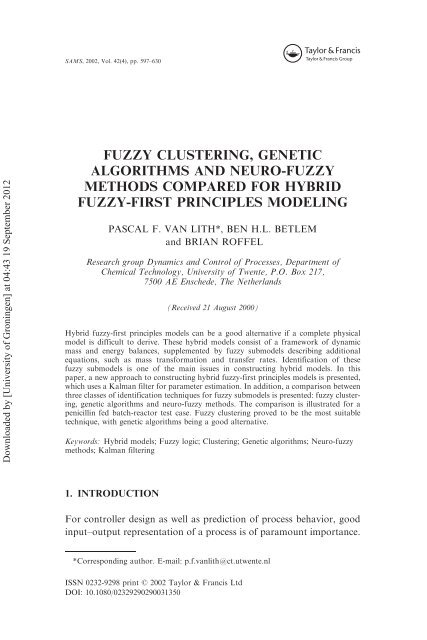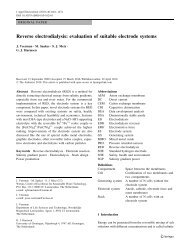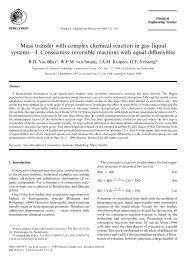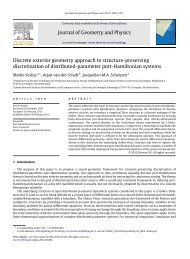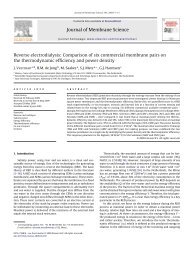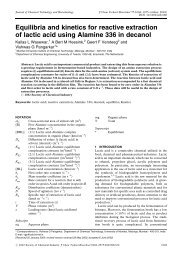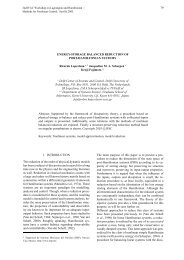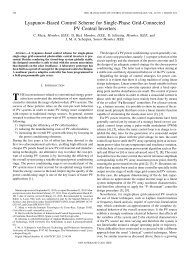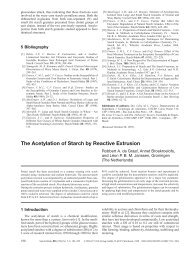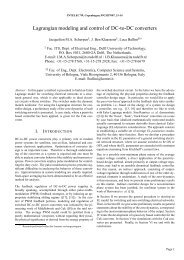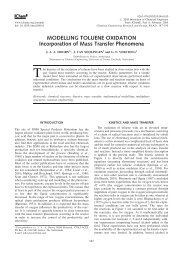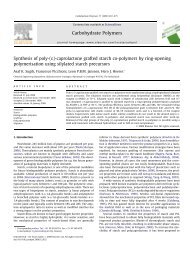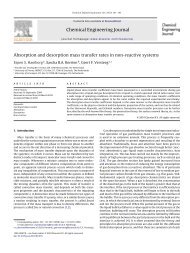FUZZY CLUSTERING, GENETIC ALGORITHMS AND NEURO ... - ITM
FUZZY CLUSTERING, GENETIC ALGORITHMS AND NEURO ... - ITM
FUZZY CLUSTERING, GENETIC ALGORITHMS AND NEURO ... - ITM
You also want an ePaper? Increase the reach of your titles
YUMPU automatically turns print PDFs into web optimized ePapers that Google loves.
SAMS, 2002, Vol. 42(4), pp. 597–630<br />
Downloaded by [University of Groningen] at 04:43 19 September 2012<br />
<strong>FUZZY</strong> <strong>CLUSTERING</strong>, <strong>GENETIC</strong><br />
<strong>ALGORITHMS</strong> <strong>AND</strong> <strong>NEURO</strong>-<strong>FUZZY</strong><br />
METHODS COMPARED FOR HYBRID<br />
<strong>FUZZY</strong>-FIRST PRINCIPLES MODELING<br />
PASCAL F. VAN LITH*, BEN H.L. BETLEM<br />
and BRIAN ROFFEL<br />
Research group Dynamics and Control of Processes, Department of<br />
Chemical Technology, University of Twente, P.O. Box 217,<br />
7500 AE Enschede, The Netherlands<br />
(Received 21 August 2000)<br />
Hybrid fuzzy-first principles models can be a good alternative if a complete physical<br />
model is difficult to derive. These hybrid models consist of a framework of dynamic<br />
mass and energy balances, supplemented by fuzzy submodels describing additional<br />
equations, such as mass transformation and transfer rates. Identification of these<br />
fuzzy submodels is one of the main issues in constructing hybrid models. In this<br />
paper, a new approach to constructing hybrid fuzzy-first principles models is presented,<br />
which uses a Kalman filter for parameter estimation. In addition, a comparison between<br />
three classes of identification techniques for fuzzy submodels is presented: fuzzy clustering,<br />
genetic algorithms and neuro-fuzzy methods. The comparison is illustrated for a<br />
penicillin fed batch-reactor test case. Fuzzy clustering proved to be the most suitable<br />
technique, with genetic algorithms being a good alternative.<br />
Keywords: Hybrid models; Fuzzy logic; Clustering; Genetic algorithms; Neuro-fuzzy<br />
methods; Kalman filtering<br />
1. INTRODUCTION<br />
For controller design as well as prediction of process behavior, good<br />
input–output representation of a process is of paramount importance.<br />
*Corresponding author. E-mail: p.f.vanlith@ct.utwente.nl<br />
ISSN 0232-9298 printß2002 Taylor & Francis Ltd<br />
DOI: 10.1080/02329290290031350
598 P.F. VAN LITH et al.<br />
Downloaded by [University of Groningen] at 04:43 19 September 2012<br />
In addition, it is required that these models are interpretable, in the<br />
sense that, by analyzing the model, there is a physical understanding<br />
of the process behavior. Many process models are available in a<br />
state-space representation. A framework of mass, component and<br />
energy balances describing the essential process accumulation can<br />
often be derived from given requirements. Within this framework,<br />
effects such as reaction rates or mass transfer are described by static<br />
empirical relations. However, for many processes, these empirical<br />
relations are complex and may have limited validity and, thus, introduce<br />
uncertainty. Examples of such processes are biotechnological<br />
processes and polymerization processes, but in principle, uncertainty<br />
can be present in any process model.<br />
Fuzzy logic could be used to deal with this uncertainty. This technique<br />
is capable of describing highly non-linear relations in a fairly<br />
simple way, without the loss of interpretability that other black box<br />
techniques have. This is a major advantage. In addition, fuzzy logic<br />
is capable of capturing human experience in a transparent way, so<br />
that these can be used to improve the process models in areas where<br />
little or no physical data exists.<br />
By combining fuzzy logic submodels with a physical model framework,<br />
hybrid fuzzy-first principles models are obtained. Combining<br />
black box techniques (such as neural networks) with physical equations<br />
is not new. However, until now, little research has been presented in<br />
which fuzzy logic is used. This paper will argue that, certainly with<br />
respect to interpretability and transparency, fuzzy logic is an extremely<br />
suitable technique to be used in hybrid modeling.<br />
To construct hybrid fuzzy-first principles models, appropriate fuzzy<br />
submodels need to be identified from human experience or process<br />
data. A problem occurs when no process measurements or human<br />
experience is available about the parameter or relationship that is to<br />
be described by a fuzzy submodel. This situation is not unlikely to<br />
appear in a real-life industrial environment. In this case, parameter<br />
or state estimation techniques can be used to solve the problem. The<br />
estimations can then be supplied to a fuzzy model identification technique<br />
to construct the fuzzy submodel.<br />
This paper will present a procedure to construct hybrid fuzzy-first<br />
principles models from process data, by making use of a Kalman<br />
filter for parameter estimation. Furthermore, three different classes
HYBRID <strong>FUZZY</strong>-FIRST PRINCIPLES MODELS 599<br />
of identification techniques for fuzzy models will be compared: fuzzy<br />
clustering, neuro-fuzzy methods and genetic algorithms.<br />
2. HYBRID MODELING<br />
Downloaded by [University of Groningen] at 04:43 19 September 2012<br />
Hybrid modeling (also denoted as semi-parametric, semi-mechanistic<br />
or polytopic modeling by some researchers) in this context denotes<br />
the combination of a black box modeling technique, in this case<br />
fuzzy logic, with first principles descriptions. Some research has been<br />
done in this area [1–4], though little of this research focuses on the<br />
use of fuzzy logic in hybrid models. Generally speaking, a distinction<br />
is made between a modular approach and a semiparametric approach,<br />
which itself falls apart into a serial and a parallel approach [1].<br />
In modular design approaches, several blocks of fuzzy logic submodels<br />
are combined to constitute the process model. The structure<br />
of the overall model is determined using prior knowledge, while<br />
every block calculates one specific variable or parameter. Advantages<br />
of this approach are that it may improve interpretability (when compared<br />
to an overall black box model) and that it can reduce the<br />
number of model parameters. A major disadvantage is that good<br />
output behavior is not guaranteed because the combination of the<br />
blocks could generate an overall divergent behavior [1].<br />
With semiparametric modeling, a fuzzy logic submodel is placed in<br />
tandem with a physical model. The physical model structure is fixed<br />
and derived from first principles. In the serial approach, the fuzzy<br />
logic submodel calculates intermediate variables to be used in the<br />
parametric model (Fig. 1). In this case, divergence is not likely to<br />
FIGURE 1<br />
Semiparametric hybrid modeling.
600 P.F. VAN LITH et al.<br />
Downloaded by [University of Groningen] at 04:43 19 September 2012<br />
occur, although this depends on the quality of the fuzzy logic submodel.<br />
In the parallel approach, the outputs of the fuzzy logic block and<br />
the physical model are combined to determine the total model output<br />
(Fig. 1). The model serves as a best estimate of the process. The<br />
fuzzy logic submodel is implemented such, that it is able to compensate<br />
for any discrepancy between the prior model output and real world<br />
values. A disadvantage of this approach is that desired behavior is<br />
not guaranteed.<br />
Research in this area has, until now, focused on Artificial Neural<br />
Networks (ANNs) as the black box modeling technique. In the context<br />
of modeling chemical processes, however, it is proposed to use fuzzy<br />
logic, as mentioned above, because fuzzy logic is capable of capturing<br />
data as well as human experience, can deal with uncertainty and can<br />
usually be interpreted physically.<br />
If first principles models are preferred over black box models, it<br />
is proposed to leave the physical model structure intact as far as possible<br />
and only model those phenomena about which uncertainty<br />
exists with fuzzy submodels. The physical model structure is formed<br />
by mass and energy balances, while the fuzzy submodel(s) describe<br />
production rates, heat and mass transfer, equilibria or growth rates,<br />
or any additional equation, if required. This way, hybrid fuzzy-first<br />
principles are obtained which combine a high level of interpretability<br />
with the expectation of good extrapolating properties. Therefore,<br />
in this research, a serial semiparametric modeling approach is used.<br />
3. PROCEDURE<br />
The procedure for constructing a hybrid model from process data is<br />
straightforward and can be formulated as:<br />
1. Establish the physical framework of the hybrid model, by determining<br />
for which relations uncertainty is present, while leaving the<br />
accumulation balance structure intact.<br />
2. Acquire input–output process data about uncertain relations (by<br />
estimation, if required).<br />
3. Identify the fuzzy submodel(s) for these uncertain relations, using<br />
the acquired input–output data.
HYBRID <strong>FUZZY</strong>-FIRST PRINCIPLES MODELS 601<br />
4. Integrate the fuzzy submodel(s) into the established accumulation<br />
balances to obtain the hybrid model.<br />
The remainder of this paper will discuss these steps with respect to a<br />
selected test case in more detail.<br />
Downloaded by [University of Groningen] at 04:43 19 September 2012<br />
4. TEST CASE<br />
To illustrate the hybrid modeling procedure, a biotechnological modeling<br />
problem has been selected. It is well known that it is difficult to<br />
develop a first principles description for such processes. The process<br />
under study is a penicillin fermentation fed-batch reactor, for which<br />
a physical model was available [1]. This model is used as a basis for<br />
developing a hybrid model and is used as a reference in the comparison<br />
of the various hybrid models that will be developed. Obviously, using<br />
this approach it is not possible to determine whether the hybrid models<br />
will outperform the known physical model. However, it is possible to<br />
illustrate the modeling procedure and to compare the different modeling<br />
techniques and it is an approach often used by other researchers,<br />
amongst others, [5].<br />
The model consists of four state equations, describing biomass concentration<br />
X (gDCW/l), substrate concentration S (g/l), product concentration<br />
P (g/l) and the overall reactor volume V (l):<br />
dX<br />
dt ¼ Xð D c LÞ ð1Þ<br />
dS<br />
dt ¼ X þ ðS f SÞD ð2Þ<br />
dP<br />
dt ¼ q pX PðD þ KÞ ð3Þ<br />
dV<br />
dt ¼ F<br />
ð4Þ<br />
where is the specific growth rate (h 1 ), c L is the cell lysis rate (h 1 ),<br />
D is the dilution rate (h 1 ), is the substrate consumption rate (h 1 ),<br />
S f is the substrate concentration in the feed (g/l), q p is the product
602 P.F. VAN LITH et al.<br />
TABLE I<br />
Settings input and process noise<br />
Variable<br />
White noise amplitude<br />
F [ 0.005, 0.005] l/h<br />
S [ 0.2, 0.2] g/l<br />
X [ 0.1, 0.1] gDCW/l<br />
Downloaded by [University of Groningen] at 04:43 19 September 2012<br />
formation rate (h 1 ), K is the product decay constant (h 1 ) and F is the<br />
feed rate (l/h). A complete description of the model is given in<br />
Appendix A. While generating process data using this model, noise<br />
was added: the settings are given in Table I. For the simulations, a<br />
discrete version of the model above (Eq. ((1)–(4)) is implemented.<br />
White noise of a certain bandwidth is added to the reference model<br />
process state at time step k. Since the state of time step k is used to<br />
calculate the state at time step k þ 1, some correlation occurs.<br />
5. Establishing the Hybrid Model Structure<br />
To test the hybrid modeling procedure, it was assumed that the rate<br />
equations in the state equation for the biomass concentration, describing<br />
the specific growth rate and the cell lysis rate, were inaccurate. The<br />
two rates were lumped together to form a net growth rate . Since the<br />
specific growth rate and the cell lysis rate both are functions of S and<br />
X, will also be a function of S and X. The goal is then to develop a<br />
hybrid model for the fed-batch reactor in which is governed by a<br />
fuzzy submodel. Equation (1) then has to be replaced by the following<br />
equation:<br />
dX<br />
dt<br />
¼ Xð DÞ ð5Þ<br />
where is the net growth rate (h 1 ). Furthermore, it is assumed that <br />
is not measurable, while the states of the model (S, X, P and V) can be<br />
measured. Since the fuzzy submodel will be identified using input–<br />
output data, the Sugeno (TSK) type fuzzy model is selected. These<br />
models are usually less complex than linguistic fuzzy models (fewer<br />
rules), which helps transparency.
HYBRID <strong>FUZZY</strong>-FIRST PRINCIPLES MODELS 603<br />
6. ACQUIRING INPUT–OUTPUT DATA<br />
Downloaded by [University of Groningen] at 04:43 19 September 2012<br />
The need for input–output data of the uncertain relation that is to be<br />
described by a fuzzy submodel is in this case only imposed by the cluster<br />
algorithm. Since the genetic algorithm approach and neuro fuzzy<br />
methods are based on ‘‘training’’ of fuzzy models, they can be implemented<br />
in such a way that they can be used to ‘‘train’’ a complete<br />
hybrid model (that is, training a fuzzy submodel within a hybrid<br />
model). This omits the need for actual input–output data about the<br />
uncertain relation, because the output of the hybrid model is used,<br />
which can be compared with the appropriate process measurements.<br />
However, to make a fair comparison, the techniques presented here<br />
are compared for identifying fuzzy submodels using input–output<br />
data of the uncertain relation.<br />
Acquiring input–output data for this problem is less complicated<br />
than for industrial plants. For the latter type of plants, two items<br />
need particular attention. First of all, the majority of the process<br />
data is available for the process under normal (usually constant) conditions,<br />
while process data about variations or upsets is limited.<br />
However, information about variations is extremely valuable for<br />
modeling purposes. Secondly, the process data that is available is<br />
often that of the controlled process. Thus it does not represent the<br />
open-loop behavior of the process for which the model is developed.<br />
This does not have to be a problem, but it does need to be taken into<br />
account when developing a model from these data. These issues are a<br />
topic of future research and do not impose a problem here. For this<br />
case, virtually no process control is available (except for the input<br />
flow rate, which is considered a constant). Furthermore, the process<br />
is not stationary and it is assumed that sufficient experiments can be<br />
carried out to obtain representative data about the process behavior.<br />
Since is not measurable, it was estimated using an extended<br />
Kalman filter as described in [6,7]. The use of estimations introduces<br />
additional uncertainty. However, it is seen as the best way to obtain<br />
information about .<br />
In the filter, no additional information about the net growth rate<br />
was assumed, except that it is a function of the substrate concentration<br />
S and the biomass concentration X. The filter was implemented in<br />
discrete form using the state Eqs. ((2)–(5)), supplemented by:
604 P.F. VAN LITH et al.<br />
kþ1 ¼ k þ w ,k<br />
ð6Þ<br />
Downloaded by [University of Groningen] at 04:43 19 September 2012<br />
where subscript k denotes the time step. t is the sampling time and<br />
w ,k is the process noise for at time step k. Process noise is simulated<br />
by adding white noise to the original process state (S, X, P and V ) at<br />
every time step. This noisy state was then used to calculate the state at<br />
the next time step, so some correlation in the process noise occurs.<br />
The process state vector for the Kalman filter is defined as<br />
X Kalman,k ¼ col( , X k , S k , P k , V k ). Using the model equations, the<br />
filter is able to make estimations of based on both process measurements<br />
(generated by the reference model) and the estimates of X,<br />
S, P and V. The filter was tuned by adjusting the diagonal elements<br />
of the noise covariance matrix Q using trial and error. The initial<br />
process state was taken the same as the process measurements at<br />
t ¼ 0. An initial estimate for the unmeasured at t ¼ 0 was also made<br />
to initialize the filter. The filter results were analyzed by observability<br />
and robustness measures from [8] and by reviewing the autocorrelation<br />
of the innovation of the filter.<br />
The Kalman filter that was developed estimates for one batch run<br />
only. Although this results in input–output data in the form of estimates<br />
of S, X, and , data from one batch run do not provide sufficient<br />
information for the input–output mapping for . Figure 2a illustrates<br />
this. To obtain sufficient information about the mapping, the filter is<br />
applied to several batch runs, each executed under different conditions,<br />
by varying the input flow rate and the initial conditions of the reactor.<br />
This provides more information about the relationship between S, X,<br />
and , as shown in Fig. 2b.<br />
FIGURE 2 as a function of S and X for one batch run (a); and as a function of S<br />
and X for 6 additional batch runs (b).
HYBRID <strong>FUZZY</strong>-FIRST PRINCIPLES MODELS 605<br />
7. IDENTIFICATION OF THE <strong>FUZZY</strong> SUBMODEL<br />
Downloaded by [University of Groningen] at 04:43 19 September 2012<br />
With the identification data set available, the fuzzy submodel for the<br />
growth rate can be developed. In this paper, three identification<br />
techniques will be compared, each of which is described in the following<br />
sections. The techniques will be used in such a way, that they can<br />
easily be compared. The resulting fuzzy models will make use of the<br />
same type of membership functions and will have similar complexity.<br />
7.1. Fuzzy Clustering<br />
The basic idea behind clustering is to divide a set of objects into selfsimilar<br />
groups (clusters), using the available data. Clustering methods<br />
usually are based on assumption about the geometry of the clusters<br />
that need to be determined, which include spheres, lines, hyperplanes,<br />
ellipsoids etc. Various clustering algorithms can be used to develop<br />
fuzzy models; a useful overview of different techniques can be found<br />
in [9]. A complete review of different clustering techniques is beyond<br />
the scope of this paper; we will focus on a well-known clustering technique<br />
for developing fuzzy models: Gustafson–Kessel (GK) clustering<br />
[10]. A detailed description of the clustering technique used in this<br />
paper is given in [11].<br />
Using the GK algorithm, it is possible to fit an a priori specified<br />
number of hyperplanes through data, approximating the system<br />
under investigation by a collection of local linear models. The fuzzy<br />
system which is determined is therefore of the Takagi–Sugeno–Kang<br />
(TSK) type. The GK algorithm searches for ellipsoidal clusters. The<br />
clustering procedure is an iterative process, in which the cluster centers<br />
are moved in the input–output space until some convergence criterion<br />
has been met. The membership values for the data features are calculated<br />
based on the distance to the cluster centers: the closer a feature<br />
is to a cluster center, the higher its membership value for that cluster<br />
is. Results about the location and the shape of the clusters is given in<br />
the form of cluster centers v i , cluster covariance matrices F i and a<br />
fuzzy partition matrix U, containing the membership values of the<br />
data features for each of the clusters. The clustering algorithm is<br />
shown in Fig. 3.
Downloaded by [University of Groningen] at 04:43 19 September 2012<br />
606 P.F. VAN LITH et al.<br />
Depending on the data that is clustered, it is not always possible to<br />
determine the correct number of clusters beforehand. A tool to help<br />
overcome this problem is the Modified Compatible Cluster Merging<br />
algorithm (MCCM) [11,12]. The main features of this technique are cri-<br />
FIGURE 3<br />
GK-clustering algorithm.
HYBRID <strong>FUZZY</strong>-FIRST PRINCIPLES MODELS 607<br />
Downloaded by [University of Groningen] at 04:43 19 September 2012<br />
teria which measure the level of compatibility of the clusters. These are<br />
based on the distances between clusters and their orientation with<br />
respect to each other. If two clusters are sufficiently close, or have<br />
the same orientation, they should be merged. A threshold value is<br />
used to determine whether clusters are close or have the same orientation.<br />
If clusters are to be merged, the GK algorithm is executed again,<br />
initialized with the new number of clusters, determined by the MCCM<br />
algorithm.<br />
After clustering is finished, the fuzzy model can be constructed.<br />
Every cluster will be represented by one rule in the fuzzy model.<br />
The premise part of the fuzzy model is determined by projecting<br />
the fuzzy partition matrix U on the appropriate input axes. Since this<br />
matrix contains membership information about the clusters with<br />
respect to the features of the identification data set, the premise<br />
part can be constructed by fitting membership functions through<br />
these projections. In this work, double sigmoid membership functions<br />
are used:<br />
ðx, a, b, c, dÞ ¼<br />
1<br />
1 þ expð aðx bÞÞ 1<br />
1 þ expðcðx d ÞÞ<br />
ð11Þ<br />
where a, c 2 < þ determine the slope of the membership functions (their<br />
‘‘fuzziness’’) and b 2 < and d 2 < þ determine its position. is a parameter<br />
that makes sure that the maximum value of the membership<br />
function is always approximately 1. This way, the fuzzy set described<br />
by the membership function is always transparent (i.e. interpretable).<br />
is calculated as follows:<br />
¼<br />
<br />
1<br />
a þ 1 <br />
ln<br />
c<br />
<br />
1<br />
0:99<br />
<br />
1 þ b<br />
ð12Þ<br />
This equation can be derived from the demand that the upward<br />
branch of the double sigmoid (first term in Eq. (11)) reaches almost<br />
one (0.99) before the downward branch (second term in Eq. (11))<br />
starts. Rewriting Eq. (11) yields the expression for . When the fuzzy<br />
partition matrix is projected, valuable information about the shape<br />
of the clusters can be lost. To overcome this problem, the clusters<br />
can be rotated to yield clearer projections. For a description of this
608 P.F. VAN LITH et al.<br />
Downloaded by [University of Groningen] at 04:43 19 September 2012<br />
procedure, the reader is referred to [11]. An alternative to rotation is the<br />
use of multidimensional membership functions, omitting the need for<br />
projection [13]. Neither techniques were necessary here.<br />
Finally, the consequence part of the fuzzy model can be calculated<br />
directly from the cluster covariance matrices F i , since the eigenvectors<br />
of these matrices will give information about the orientation of the<br />
hyperplanes. These hyperplanes will be described by the consequence<br />
part of the fuzzy model. Calculation of the consequence part parameters<br />
can be done using the n 1 eigenvectors corresponding with<br />
the n 1 largest eigenvalues of a cluster, which span the hyperplane<br />
[11], or with the eigenvector corresponding to the smallest eigenvalue,<br />
which determines the normal vector to the hyperplane [14]. Least<br />
squares methods can also be used to determine the consequence part<br />
parameters [14].<br />
Summarizing, the complete identification algorithm is as follows:<br />
1. Choose the process input variables and output variable. Determine<br />
the initial number of clusters k max .<br />
2. Perform GK-clustering.<br />
3. Perform MCCM cluster merging. If clusters are to be merged, go to<br />
step 2 and recluster, using the number of clusters determined by the<br />
merging algorithm. If not, go to step 4.<br />
4. Determine the premise part of the fuzzy model by projection of the<br />
fuzzy partition matrix U and rotation, if necessary, or by use of<br />
multidimensional membership functions.<br />
5. Determine the consequence part of the fuzzy model from the cluster<br />
covariance matrices F i .<br />
7.2. Genetic Algorithms<br />
Genetic Algorithms (GAs) are well known for their optimization capabilities.<br />
Following basic Darwinistic propagation, the method is<br />
based on a ‘‘survival of the fittest’’ principle, where only the solution<br />
candidates with the best desirable properties (e.g. smallest error)<br />
will survive. In essence, a ‘‘population’’ of possible solution candidates<br />
for the optimization problem (e.g. models that need to describe
HYBRID <strong>FUZZY</strong>-FIRST PRINCIPLES MODELS 609<br />
Downloaded by [University of Groningen] at 04:43 19 September 2012<br />
measurement data as good as possible) is created in an ‘‘environment’’,<br />
in which only a limited number of candidates can survive. The candidates<br />
that will survive are selected by evaluating their fitness value<br />
through the fitness function (similar to the objective function in<br />
more traditional optimization algorithms). The candidates with<br />
the lowest fitness value are removed, the candidates with the highest<br />
fitness values are propagated into the next ‘‘generation’’ (iteration<br />
step). During this propagation, ‘‘reproduction’’ occurs, in which the<br />
best candidates are copied to take the place of the candidates that<br />
are removed from the population. Some random effects can occur,<br />
such as ‘‘mutation’’ (random change in the properties of a candidate<br />
solution) and ‘‘cross over’’ (exchange of information between two<br />
candidate solutions). The procedure is iterative and is terminated<br />
when some convergence criterion is met, usually when the maximum<br />
number of iterations is reached or when there is no more increase in<br />
fitness.<br />
The possible solution candidates are coded in the form of parameter<br />
strings, usually utilizing binary coding. These codings are often called<br />
‘‘chromosomes’’. In GAs, reproduction, mutation and crossover are<br />
all executed on these chromosomes.<br />
Compared to conventional optimization algorithms, GAs are different<br />
in a number of ways [15]:<br />
. GAs work with a coding of the parameter set, not the parameters<br />
themselves<br />
. GAs search from a population of points, not a single point, and<br />
therefore are more robust with respect to becoming trapped in<br />
local optima than other algorithms<br />
. GAs use payoff (objective function) information, not derivatives or<br />
other auxiliary knowledge<br />
. GAs use probabilistic transition rules, not deterministic rules, i.e.,<br />
GAs use random experiments to select new candidates which are<br />
likely to be better.<br />
A useful overview of theory and applications of GAs can be found<br />
in [15].
610 P.F. VAN LITH et al.<br />
Downloaded by [University of Groningen] at 04:43 19 September 2012<br />
Using GAs, it is possible to develop a fuzzy system and many applications<br />
have already been reported [16]. Using GAs to optimize fuzzy<br />
systems, the fuzzy system needs to be coded into chromosomes.<br />
There are numerous texts available which describe different approaches<br />
to the coding problem. Here, a relatively straightforward coding<br />
scheme is used. A distinction is made between coding of linguistic<br />
(Mamdani) type fuzzy models and TSK type fuzzy models.<br />
The objective function (or fitness function) that was used is the same<br />
for both types of fuzzy models, and is given by:<br />
Jð’ fuzzy Þ ¼<br />
1 M<br />
X M<br />
i¼1<br />
ðf fuzzy ðx i,1 , . . . , x i,n 1 Þ x i,n Þ 2 ! 1=2<br />
ð13Þ<br />
which represents the root mean squared error with respect to the n<br />
dimensional identification data x.<br />
When coding linguistic fuzzy models, the parameters of all of the<br />
membership functions are coded into the chromosome, so that the<br />
membership functions of the fuzzy model can be optimized. In addition,<br />
the rule structure can also be coded, enabling rule structure<br />
optimization. Figure 4 shows how the chromosomes are constructed.<br />
The model parameters are supplied to the GA using real-valued<br />
(non-binary) parameters. The GA translates these real values to a<br />
binary representation. Therefore, extra information needs to be supplied<br />
to the GA about the parameters, such as an allowed parameter<br />
interval (to which the binary coding is mapped) and a parameter<br />
FIGURE 4<br />
Coding of a 2-rule linguistic fuzzy model into a chromosome.
HYBRID <strong>FUZZY</strong>-FIRST PRINCIPLES MODELS 611<br />
Downloaded by [University of Groningen] at 04:43 19 September 2012<br />
resolution (to determine the bit string length per parameter). These can<br />
be chosen individually per parameter.<br />
The same coding scheme can be followed when coding TSK type<br />
fuzzy models. However, as mentioned before, when the premise<br />
part of the fuzzy model is known, the consequence part can be calculated<br />
easily using least squares methods. Therefore, only the premise<br />
part parameters and the rule structure are coded into chromosomes,<br />
and the consequence part parameters are calculated directly using<br />
a least squares approach, without intervention of the GA. This is<br />
similar to the learning algorithm that is used in the Adaptive Network<br />
based Fuzzy Inference system (ANFIS) method [17]. Coding TSK<br />
models this way reduces the length of the chromosomes (the last part<br />
can be omitted, see Fig. 4) and the search space of the optimization<br />
algorithm, improving the speed and performance of the GA.<br />
The consequence part is calculated as follows [14]. The consequence<br />
part of the rule i of the fuzzy model for some n dimensional data vector<br />
x with n 1 inputs is given by:<br />
y f ,i ¼ ½x i . . . x n 1 1Šh i ð14Þ<br />
in which y f,i is the output of rule i and h i is the consequence part parameter<br />
vector for rule i.<br />
Given the identification data set, consisting of M n-dimensional<br />
vectors x, define a M by a n matrix P, with the first n 1 elements of<br />
x k on the kth row. Append this matrix with a unitary column as the<br />
nth column. Furthermore, define the vector y with the nth element of<br />
x k on the kth row. This gives:<br />
2<br />
3 2<br />
x 1,1 . . . x 1,n 1 1<br />
x 2,1 . . . x 2,n 1 1<br />
P ¼<br />
. .<br />
.<br />
. .<br />
. . , y ¼<br />
6<br />
4<br />
7 6<br />
5 4<br />
x M,1 . . . x M,n 1 1<br />
x 1,n<br />
x 2,n<br />
.<br />
.<br />
x M,n<br />
3<br />
7<br />
5<br />
ð15Þ<br />
To calculate the consequence part parameters vectorh i of rule i of the<br />
fuzzy model, first multiply each row k of P and y with the square root of
612 P.F. VAN LITH et al.<br />
the degree of fire of rule i for data vector k, i,k . This gives:<br />
Downloaded by [University of Groningen] at 04:43 19 September 2012<br />
2<br />
ð i,1 Þ 1=2 x 1,1 . . . ð i,1 Þ 1=2 x 1,n 1 ð i,1 Þ 1=2 3<br />
ð i,2 Þ 1=2 x 2,1 . . . ð i,2 Þ 1=2 x 2,n 1 ð i,2 Þ 1=2<br />
~P i ¼<br />
. . . . . . 6<br />
7<br />
4<br />
5 ,<br />
ð i,M Þ 1=2 x M,1 . . . ð i,M Þ 1=2 x M,n 1 ð i,M Þ 1=2<br />
2<br />
ð i,1 Þ 1=2 3<br />
x 1,n<br />
ð i,2 Þ 1=2 x 2,n<br />
~y ¼<br />
6 . 7<br />
4<br />
5<br />
ð i,M Þ 1=2 x M,n<br />
ð16Þ<br />
The solution of the least squares problem of y ¼ Ph i þ ", is given by:<br />
h i ¼ ½ ~P T i<br />
~P i Š<br />
1 ~P T i<br />
~y i ð17Þ<br />
This procedure is repeated for each rule in the model.<br />
With TSK models, as with linguistic fuzzy models, it is possible to<br />
code only the membership function parameters or both the parameters<br />
and the rule structure. However, rule structure optimization may not<br />
always be necessary. For fully connected rule bases, the optimization<br />
structure proposed here does not need rule base optimization. Since<br />
every possible combination of antecedent membership functions is<br />
present, and since the calculation of the consequence parameters is<br />
based on the premise part of the rule structure, calculation of the consequence<br />
parameters will yield the same results for the situation with and<br />
without rule base optimization. The only difference will be that the<br />
rules will be in a different order. For cluster-like connected rule<br />
bases, every antecedent membership function occurs only once. This<br />
way, the rule base described independent ‘‘clusters’’ in the input<br />
space. Since these clusters can be moved around freely by the GA,<br />
rule structure optimization by the GA is not necessary.<br />
The membership functions used in the antecedent part are double<br />
sigmoids, the same as used with clustering. The optimization procedure<br />
can be refined (constrained) by imposing demands on the level of overlap<br />
of the antecedent membership functions and their location, for
HYBRID <strong>FUZZY</strong>-FIRST PRINCIPLES MODELS 613<br />
example. Although this imposes restrictions on the optimization, it<br />
does ensure that the resulting fuzzy models remain transparent,<br />
which in this case is seen as a requirement. The constraints were implemented<br />
for each input variable in the following way:<br />
a i ¼ c i<br />
<br />
1<br />
b i ¼ d i 1 þ <br />
i ¼ 2, . . . , n MF 1 ð18Þ<br />
Downloaded by [University of Groningen] at 04:43 19 September 2012<br />
with a i . . .d i denoting the membership function parameters as in<br />
Eq. (11) for membership function i and n MF the number of membership<br />
functions on the concerning input. The first and the last membership<br />
functions on the input variable are chosen as shouldered<br />
membership functions, described by single sigmoids. The restrictions<br />
make sure that two adjacent membership functions sum up to one:<br />
they form a fuzzy partition. In addition to preservation of transparency,<br />
the number of parameters for optimization is reduced. These<br />
constraints are not necessary for cluster-like connected rule bases,<br />
because for these rule bases the locations of the described ‘‘clusters’’<br />
do not have to be orthogonal, as is the case with fully connected<br />
rule bases.<br />
To summarize, only the parameters of the antecedent membership<br />
functions are coded into chromosomes. These chromosomes are thus<br />
a special case of the general representation illustrated in Fig. 4.<br />
7.3. Neuro-Fuzzy Methods<br />
Neuro-fuzzy methods can be viewed upon as a combination of fuzzy<br />
systems and artificial neural networks (ANNs). The fuzzy inference<br />
system is implemented in the framework of these adaptive networks.<br />
This provides the possibility to use backpropagation learning rules,<br />
commonly used to train these nets. Several approaches have been<br />
developed in the past. Some of these have been applied within the context<br />
of hybrid modeling, such as NEFPROX [18] and ASMOD [19],<br />
covering both linguistic and TSK type fuzzy models. For TSK<br />
models, Jang’s Adaptive Network based Fuzzy Inference System<br />
(ANFIS) approach is used [17].<br />
Jang interprets a TSK type fuzzy system as an adaptive network, on<br />
which adaptive learning rules can be applied to optimize the system
614 P.F. VAN LITH et al.<br />
Downloaded by [University of Groningen] at 04:43 19 September 2012<br />
FIGURE 5 2 by 1 TSK model and corresponding ANFIS interpretation; the nodes in<br />
layer 1 contain the membership functions, layer 2 determines the degree of firing, layer 3<br />
calculates the weighted degree of firing, layer 4 calculates the weighted rule outputs and<br />
layer 5 calculates the crisp model output.<br />
parameters. The interpretation is illustrated in Fig. 5. Parameter<br />
optimization is carried out using a so-called forward pass and a backward<br />
pass. During every iteration, the consequence part parameters<br />
of the fuzzy model are determined using the same least squares<br />
approach as used with GA’s (see Eqs. ((14)–(17)). An alternate<br />
approach to the least squares calculation given by Eqs. ((14)–(17)) is<br />
an iterative calculation of the solution to the least squares problem<br />
[17]. In this approach, no matrix inversion is used which results in a<br />
computationally more efficient calculation. However, for the problem<br />
presented here and the software available today, matrix inversion is<br />
not a problem. Calculation of the consequence parameters is called<br />
the forward pass. In the backward pass, the error rates propagate backwards<br />
and the premise part parameters are updated by a standard<br />
gradient descent learning rule (see [17]). These steps are performed<br />
iteratively until some criterion is satisfied, for example, until the<br />
change in parameters is very small.<br />
The procedure starts with an initial fuzzy model. This model is<br />
trained by optimizing its membership function parameters, while the<br />
rule structure is left intact. This means that the rule structure needs
HYBRID <strong>FUZZY</strong>-FIRST PRINCIPLES MODELS 615<br />
to be defined beforehead. Determining the rule base can be done by<br />
using heuristic knowledge or visual inspection of the input–output<br />
data. An initial rule base can also be constructed by performing clustering<br />
in the input space of the data. This is not investigated here. The<br />
double sigmoid membership functions described earlier are also<br />
deployed here.<br />
Downloaded by [University of Groningen] at 04:43 19 September 2012<br />
8. HYBRID MODELING RESULTS<br />
8.1. Data Preparation<br />
Because of the quadratic optimization criteria, the distribution of the<br />
data features is important for all of the identification techniques used<br />
in this research. The data set that was generated by the Kalman filter<br />
shows areas with high and low density of data features, so the set was<br />
manipulated to obtain a more even distribution of the data features in<br />
the input space. This was done by performing a heuristic step: all<br />
features present in the data set must have some minimum distance<br />
to its neighbors. The data set, generated by 16 batch runs under different<br />
conditions, contains 129 data features after this step.<br />
8.2. Fuzzy Clustering<br />
The identification data set was supplied to the clustering algorithm.<br />
The initial number of clusters was set relatively high, and the cluster<br />
merging threshold was set using trail and error. Settings for the clustering<br />
algorithm are shown in Table II. The resulting fuzzy submodel<br />
for as a function of S and X consists of three rules (see appendix B,<br />
Fig. 13). Hybrid modeling results are shown in Figs. 6–8. The figures<br />
show reference measurements of X and P of a batch run, as well as<br />
the results of a free run of the hybrid model. That is, the model is initialized<br />
with a given state and the model uses its own state calculations<br />
to simulate the process. Thus modeling errors are propagated as the<br />
TABLE II<br />
Settings clusteralgorithm<br />
Initial number of clusters k max 5<br />
Cluster merging threshold 0.5<br />
Cluster termination criterion " GK 0.01
616 P.F. VAN LITH et al.<br />
Downloaded by [University of Groningen] at 04:43 19 September 2012<br />
FIGURE 6<br />
FIGURE 7<br />
Hybrid modeling results: X for one batch run.<br />
Hybrid modeling results: P for one batch run.<br />
simulation advances. If the model is used for, say, one-step-ahead prediction<br />
using measurement feedback, these discrepancies would not<br />
occur. However, one of the intentions of the model was that it could<br />
be used for off-line simulation studies, and this is why it was decided<br />
to present free runs. Furthermore, the corresponding trajectories of <br />
are given. A more elaborate discussion will follow later. Model errors<br />
are shown in Table VI.
HYBRID <strong>FUZZY</strong>-FIRST PRINCIPLES MODELS 617<br />
Downloaded by [University of Groningen] at 04:43 19 September 2012<br />
FIGURE 8<br />
Hybrid modeling results: for one batch run.<br />
FIGURE 9 Input space and rule locations for fuzzy model obtained with clustering.<br />
Contour plot indicates degree of fire, dots indicate input data.<br />
The three rules can be interpreted physically as each describing an<br />
operation phase of the batch reactor (see Fig. 9). The first rule describes<br />
in the first phase of the batch run (low X, relatively high S), the third<br />
rule describes at the end of a batch run under normal conditions (high<br />
X, low S) and the second rule describes an intermediate phase.<br />
8.3. Genetic Algorithm<br />
A comparison is made between a fully connected rule base and a rule<br />
base with cluster-like connections. The initial model contains four
618 P.F. VAN LITH et al.<br />
Downloaded by [University of Groningen] at 04:43 19 September 2012<br />
rules for both type of connections. Initialization of the premise part<br />
membership functions does not play a role here: this is done by<br />
the GA, randomly. Settings of the GA are shown in Tables III<br />
and IV, the resulting fuzzy models can be found in appendix B<br />
(Figs. 14 and 15).<br />
For the fuzzy model with the fully connected rule base, the optimization<br />
resulted in maximum values for the a and c parameters of all the<br />
membership functions. This is a result of the interpolation properties<br />
of TSK models and has been discussed before [11,14]. These parameters<br />
determine the level of overlap between the fuzzy sets, i.e. the ‘‘fuzziness’’<br />
of the sets. The higher these parameters, the crisper the sets.<br />
To prevent the sets from becoming too crisp, suitable maximum<br />
values for a and c were determined experimentally. Hybrid modeling<br />
results for a free run of the model are shown in Figs. 6–8.<br />
For the cluster-like connected rule base, the GA had the tendency to<br />
move all of the clusters outside the input space (Fig. 10). A suitable fit<br />
could still be found, because the sigmoid membership functions never<br />
become zero, so the fuzzy inference mechanism still functions properly.<br />
TABLE III<br />
TSK model, fully connected rule base<br />
Settings GA, fully connected rule base<br />
Number of membership functions on S 2<br />
Number of membership functions on X 2<br />
Number of rules 4<br />
Number of chromosomes 77<br />
Number of generations 77<br />
Propagation selection criterion<br />
Tournament<br />
Probability of crossover (1 point crossover) 0.77<br />
Probability of mutation 0.0077<br />
TABLE IV<br />
Settings GA, cluster-like connected rule base<br />
TSK model, cluster-like connected rule base<br />
Number of membership functions on S 2<br />
Number of membership functions on X 2<br />
Number of rules 2<br />
Number of chromosomes 77<br />
Number of generations 77<br />
Propagation selection criterion<br />
Tournament<br />
Probability of crossover (1 point crossover) 0.77<br />
Probability of mutation 0.0077
HYBRID <strong>FUZZY</strong>-FIRST PRINCIPLES MODELS 619<br />
Downloaded by [University of Groningen] at 04:43 19 September 2012<br />
FIGURE 10 Input space and rule locations for fuzzy model obtained with genetic<br />
algorithm, fully connected rule base. Contour plot indicates degree of fire, dots indicate<br />
input data.<br />
Extra penalties were introduced in the objective function to overcome<br />
this: fuzzy models with clusters that describe areas without identification<br />
data in the input space are reduced in fitness. This resulted in<br />
a suitable model. Initially, a run with four clusters was made.<br />
However, this resulted in a model where some of the clusters completely<br />
overlapped, indicating a too complex model. Eventually, a model with<br />
2 clusters was developed (see appendix B), resulting in a response<br />
shown in Figs. 6–8.<br />
Physically, the interpretation of the rules is similar to the interpretation<br />
given for the fuzzy model that was constructed with fuzzy<br />
clustering (Fig. 11). It can be seen that the rules make a distinction<br />
between the first phase and the latter phase of a batch run under<br />
normal conditions (i.e., without an extraordinary high biomass concentration<br />
at t ¼ 0). This is consistent with what would be expected,<br />
because most of the dynamics in are present in the first phase of a<br />
batch run.<br />
8.4. Neuro Fuzzy Method<br />
As with GA, optimization of a four rule fuzzy model with fully<br />
connected rule base was compared with optimization of a four<br />
rule fuzzy model with a cluster-like connected rule base. However,
620 P.F. VAN LITH et al.<br />
Downloaded by [University of Groningen] at 04:43 19 September 2012<br />
FIGURE 11 Input space and rule locations for fuzzy model obtained with genetic<br />
algorithm, cluster-like connected rule base. Contour plot indicates degree of fire, dots<br />
indicate input data.<br />
initialization plays an important role. If both type of models are initialized<br />
so that they are essentially the same (same degree of fire of<br />
the four rules and same consequence parameters), it was found that<br />
optimization leads to virtually the same results. In that case, a fully<br />
connected rule base is preferable, because this reduces the number of<br />
model parameters.<br />
Careful inspection of the data set can be used to determine a more<br />
suitable premise part of the initial fuzzy model instead of a general initialization.<br />
However, this may be cumbersome and not always possible<br />
with high dimensional input spaces. Inspection of the data set used here<br />
resulted in a simple 4-rule model with a fully connected rule base and<br />
two evenly spaced sigmoid membership functions on both S and X.<br />
Settings for ANFIS are shown in Table V. They fuzzy model identified<br />
with ANFIS can be found in appendix B, Fig. 16. Results of the<br />
hybrid model are shown in Figs. 6–8. As can be seen, the interpretability<br />
with respect to X is deteriorated by the optimization. The overlap<br />
between the two sets has become large and the membership functions<br />
do not reach 1. Furthermore, the output of rule four is out of proportion<br />
with respect to the other three rules. This is the result of
HYBRID <strong>FUZZY</strong>-FIRST PRINCIPLES MODELS 621<br />
TABLE V<br />
Settings ANFIS<br />
TSK model, fully connected rule base<br />
Number of membership functions on S 2<br />
Number of membership functions on X 2<br />
Number of rules 4<br />
Number of training epochs 1000<br />
Initial learning rate 0.01<br />
Learning rate decrease rate 0.9<br />
Learning rate increase rate 1.1<br />
Downloaded by [University of Groningen] at 04:43 19 September 2012<br />
optimization in an area where no data is available. This shows that<br />
extrapolating this fuzzy model has indeed no physical meaning.<br />
The effect of the optimization of the consequence part is much larger<br />
than the effect of the optimization of the premise part. If only the<br />
consequence parameters of the initial fuzzy model, before premise<br />
part optimization, are optimized using the least squares method, the<br />
RMSE will drop to the same order of magnitude as the RMSE after<br />
premise part optimization. Therefore, changes in the form of premise<br />
part membership function parameter adjustments will have a relatively<br />
small effect on model performance. This could be an explanation for<br />
the deterioration of the interpretability of the premise part of the<br />
fuzzy model: the shape of the membership functions is less relevant<br />
because changes in shape and position will not have a large effect on<br />
the performance criterion. The reason why this does not occur with<br />
the GA is because the GA searches the optimization space much<br />
more effectively. Instead of following a steepest descent path (leading<br />
to a local optimum), the GA optimizes several possible solutions distributed<br />
randomly in the search spaces and is thus less likely to get<br />
stuck in one optimum.<br />
The physical interpretation of this fuzzy model is much more complicated,<br />
because the adjustments of the premise part are dependent on the<br />
initialization and, in this case, are minor (see Fig. 12).<br />
9. COMPARISON<br />
Since all of the fuzzy submodels use the same fuzzy model structure<br />
and the same type of membership functions, comparison of the per-
622 P.F. VAN LITH et al.<br />
Downloaded by [University of Groningen] at 04:43 19 September 2012<br />
FIGURE 12 Input space and rule locations for fuzzy model obtained with ANFIS.<br />
Contour plot indicates degree of fire, dots indicate input data.<br />
formance of the different technique is possible. The most important<br />
criteria for comparison in this work are:<br />
. Modeling errors.<br />
. Transparency and interpretability of the identified models.<br />
. Sensitivity to initialization.<br />
With respect to modeling errors, it can be seen in Figs. 6–8 that all of<br />
the constructed hybrid models perform comparably. All techniques are<br />
capable of producing a fuzzy submodel with acceptable performance.<br />
The differences between the hybrid models are caused by the various<br />
submodels for , since the physical model structure is the same for<br />
all of the hybrid models. This discrepancy with the measurements is<br />
caused by a series of errors. First of all, the fuzzy submodels are<br />
identified using estimates of . Furthermore, the submodels are fit to<br />
these estimates, introducing fitting errors. Finally, as mentioned<br />
before, the runs in Figs. 6–8 are free runs, which means that model<br />
errors are propagated through the simulation run by integration and<br />
will increase in magnitude. Modeling errors can be reduced by optimizing<br />
the parameters of the fuzzy submodel once the hybrid model is<br />
constructed, by using hybrid model output and state measurements<br />
(Table VI). This is a topic for future research. Since every identification<br />
technique yielded a suitable fuzzy submodel, it is interesting to make a
HYBRID <strong>FUZZY</strong>-FIRST PRINCIPLES MODELS 623<br />
TABLE VI<br />
Hybrid modelling errors<br />
Identification method " RMSE " integrated, X<br />
Fuzzy Clustering 0.0083 72.82<br />
Genetic Algorithm, fully connected 0.0083 249.9<br />
Genetic Algorithm, cluster-like connected 0.0089 93.15<br />
Neurofuzzy method 0.0071 70.54<br />
Downloaded by [University of Groningen] at 04:43 19 September 2012<br />
comparison about the construction of the fuzzy submodels using<br />
the different techniques rather than a comparison about model<br />
performance.<br />
The main advantage of fuzzy clustering is that it automatically<br />
determines the fuzzy model structure. Initialization was not an issue.<br />
With respect to transparency and interpretability, the clustering algorithm<br />
performed very well. The model that was obtained is simple and it<br />
was possible to give a physical interpretation afterwards.<br />
Although computationally demanding, the two-step identification<br />
approach of the genetic algorithm worked especially well with clusterlike<br />
connected rule bases. This gave the GA the possibility to shift<br />
rules independently of each other. It was also possible to give a physical<br />
interpretation of the model. However, the fuzzy model structure must be<br />
given in advance. This is a disadvantage: it may be very difficult to define<br />
an optimal fuzzy model structure in advance. Some researchers have<br />
proposed to use clustering in the input space of the system to obtain<br />
an initial idea about the fuzzy sets that are required, but for the functional<br />
relationships investigated in this work clustering in the input–<br />
output space seems more logical. An advantage of the GA is that it<br />
can be used to ‘‘train’’ a complete hybrid model. Since the GA works<br />
with an initial fuzzy submodel, this submodel can be used to construct<br />
an ‘‘initial hybrid model’’. Thus instead of using input–output data of<br />
the uncertain relation to train the fuzzy submodel, the GA can also<br />
use output data of the hybrid model to train the fuzzy submodel within<br />
the hybrid model. In this case, the need for the Kalman filter is eliminated.<br />
The proposed approach is currently under investigation.<br />
A similar approach can be followed using a neuro-fuzzy identification<br />
method. However, since initialization of the fuzzy submodel<br />
before optimization has a high impact on the result, this may be a difficult<br />
task. Although a good fuzzy submodel was obtained using<br />
ANFIS, the method had the tendency to change the membership
624 P.F. VAN LITH et al.<br />
functions in such a way that interpretation was often difficult, while the<br />
location of the membership functions was changed very little. This<br />
makes the method very sensitive to initialization. Consequently, the<br />
other two identification methods are more desirable alternatives.<br />
Downloaded by [University of Groningen] at 04:43 19 September 2012<br />
10. CONCLUSIONS<br />
In this paper, we presented a successful approach to constructing<br />
hybrid fuzzy-first principles models from process data. Three different<br />
identification techniques for the construction of the fuzzy submodel<br />
for the net growth rate were applied successfully and compared.<br />
Of these three, fuzzy clustering was found to be the best alternative,<br />
because it determines the fuzzy model structure itself from the process<br />
data at hand. The cluster-like connected rule base results in a transparent<br />
and interpretable fuzzy submodel with excellent simulation<br />
performance.<br />
A genetic algorithm approach is a good alternative to fuzzy clustering,<br />
with cluster-like connected rule bases giving good results.<br />
Although the model is less interpretable than with fuzzy clustering,<br />
the approach has the advantage that it can be applied so that no<br />
input-output data or estimations of the uncertain relation need to be<br />
available, which is an advantage above fuzzy clustering. However, in<br />
this case, a deliberation needs to be made between the excellent transparency<br />
of fuzzy models constructed with clustering (but additional<br />
uncertainty introduced by estimations) and the somewhat lesser interpretability<br />
of fuzzy submodels constructed with a GA (but with no<br />
additional uncertainty caused by estimations).<br />
The major drawback of ANFIS is its sensitivity to initialization of<br />
the problem. As with GA, the structure must be provided, as an initial<br />
guess of membership parameters. An optimum is found from there.<br />
Other neuro-fuzzy approaches, like ASMOD and NEFPROX, provide<br />
mechanisms of determining the model structure automatically. These<br />
mechanisms could be incorporated in the ANFIS technique. Given<br />
the requirements for this research, genetic algorithms and fuzzy<br />
clustering provide good alternatives, with fuzzy clustering the best<br />
option, if input–output data or estimations are available.
HYBRID <strong>FUZZY</strong>-FIRST PRINCIPLES MODELS 625<br />
Acknowledgements<br />
The contributions of Coen Noppert and Yu¨ cel Ko¨ k are gratefully<br />
acknowledged.<br />
NOTATION<br />
Downloaded by [University of Groningen] at 04:43 19 September 2012<br />
c L Cell lysis rate (h 1 )<br />
c Lm Constant (h 1 )<br />
D Dilution rate, F/V (h 1 )<br />
F Feed flow rate (l/h)<br />
f fuzzy Fuzzy model<br />
F i Covariance matrix for cluster i<br />
J Objective function for the GA<br />
K Product decay constant (h 1 )<br />
k Number of clusters<br />
K I Constant (g/l)<br />
K L Constant (g/l)<br />
K P Constant (g/l)<br />
K X Constant ( )<br />
M Number of identification data features<br />
m e Fuzzy exponent<br />
m x Maintenance energy factor<br />
m xm Constant (h 1 )<br />
n Dimension of the input–output space of the identification<br />
problem<br />
P Product concentration (g/l)<br />
q p Product formation rate (h 1 )<br />
q qm Constant (h 1 )<br />
S Substrate concentration (g/l)<br />
S f Substrate concentration in the feed (g/l)<br />
V Reactor volume (I)<br />
w k Process noise vector at time step k<br />
X Biomass concentration (gDCW/l)<br />
x n-dimensional data feature vector<br />
x Kalman,k Process state vector for the Kalman filter<br />
Y P/S Yield factor which relates production rate and substrate<br />
consumption
626 P.F. VAN LITH et al.<br />
Downloaded by [University of Groningen] at 04:43 19 September 2012<br />
Y X/S Yield factor which relates cell growth rate and substrate<br />
consumption<br />
Net growth rate c L (h 1 )<br />
i,k Degree of Fire (DOF) of rule i for data feature k<br />
Additional parameter for double sigmoid membership<br />
function (–)<br />
" integrated Integral error<br />
" GK Termination criterion for the GK algorithm<br />
" RMSE Root Mean Squared Error<br />
h i Fuzzy model consequence part parameters for rule i<br />
Specific growth rate (h 1 )<br />
Membership value ( )<br />
m Constant (h 1 )<br />
v i center of cluster i<br />
Substrate consumption rate (h 1 )<br />
’ fuzzy Fuzzy model parameter vector<br />
APPENDIX A: BIOREACTOR MODEL<br />
The model describes four states of the process, namely the cell biomass<br />
concentration X (in gDCW/1, where DCW means dry cell weight), the<br />
substrate concentration S (in g/l), product concentration P (g/l) and<br />
the overall volume V (1). Four state equations describe these states<br />
dX<br />
dt ¼ Xð D c LÞ ð19Þ<br />
dS<br />
dt ¼ X þ ðS f SÞD ð20Þ<br />
dP<br />
dt ¼ q pX PðD þ KÞ ð21Þ<br />
dV<br />
dt ¼ F<br />
ð22Þ<br />
with<br />
S f<br />
Substrate concentration in feed (g/l)
HYBRID <strong>FUZZY</strong>-FIRST PRINCIPLES MODELS 627<br />
K product decay constant (h 1 )<br />
D dilution rate F/V (h 1 )<br />
All the other symbols govern specific rates which play a role in the<br />
process as defined below.<br />
Growth rate<br />
Downloaded by [University of Groningen] at 04:43 19 September 2012<br />
The equation for the specific growth rate is an adaptation of the<br />
Contois Eq. [20], which in itself is a special form of the well-known<br />
Monod equation.<br />
Cell lysis rate<br />
¼<br />
mS<br />
K X X þ 10<br />
ð23Þ<br />
Cell lysis, the dying of the biomass, is usually expressed by an exponential<br />
decrease in biomass. In this case, expressed by<br />
c L ¼<br />
(Numbers in the equation may have units)<br />
Product formation rate<br />
c Lm X<br />
expð S=100Þ ð24Þ<br />
K L þ X þ 1<br />
The specific product formation rate q P will vary with S and X according<br />
to<br />
1:5q pm SX<br />
q p ¼<br />
4K p þ XSð1 þ S=3K I Þ<br />
(Numbers in the equation may have units)<br />
ð25Þ<br />
Substrate consumption rate<br />
The rate of uptake of substrate by micro-organisms is generally considered<br />
to be either related to that of growth or to that required for<br />
cell maintenance. The specific substrate consumption rate is given by<br />
¼<br />
<br />
Y x=s<br />
þ q p<br />
Y p=s<br />
þ m x<br />
ð26Þ
628 P.F. VAN LITH et al.<br />
Maintenance energy<br />
The substrate consumption rate needed for non-growth functions, the<br />
maintenance energy factor, is expressed by<br />
m x ¼ m xmX<br />
X þ 10<br />
ð27Þ<br />
Downloaded by [University of Groningen] at 04:43 19 September 2012<br />
(Numbers in the equation may have units)<br />
APPENDIX B: <strong>FUZZY</strong> MODELLING RESULTS<br />
FIGURE 13 Fuzzy model for identified with fuzzy clustering. Dots indicate identification<br />
data, the plane indicates the fuzzy model output.<br />
FIGURE 14 Fuzzy model for identified with the GA, fully connected rule base.<br />
Dots indicate identification data, the plane indicates the fuzzy model output.
HYBRID <strong>FUZZY</strong>-FIRST PRINCIPLES MODELS 629<br />
Downloaded by [University of Groningen] at 04:43 19 September 2012<br />
FIGURE 15 Fuzzy model for identified with the GA, cluster-like connected rule<br />
base. Dots indicate identification data, the plane indicates the fuzzy model output.<br />
FIGURE 16 Fuzzy model for identified with ANFIS. Dots indicate identification<br />
data, the plane indicates the fuzzy model output.<br />
References<br />
[1] M.L. Thompson and M.A. Kramer (1994). Modeling chemical processes using prior<br />
knowledge and neural networks. AIChE Journal, 40(8), 1328–1340.<br />
[2] D.C. Psichogios and L.H. Ungar (1992). A hybride neural network-first principles<br />
approach to process modeling. AIChE Journal, 38(10), 1499–1511.<br />
[3] O. Otto and K. Hartmann (1996). Hybrides Modell eines Sichters auf der Basis ku¨ nstlicher<br />
Neuronaler Netze. Chemie Ingenieur Technik, 68(12), 1578–1581.<br />
[4] J.A. Roubos, P. Krabben, M. Setnes, R. Babuska, J.J. Heijnen and H.B. Verbruggen<br />
(8–9 September 1999). Hybrid model development for fed-batch bioprocesses; combining<br />
physical equations with the metabolic network and black-box kinetics, in 6th UK<br />
Workshop on Fuzzy Systems. pp. 231–239. Uxbridge, UK.
630 P.F. VAN LITH et al.<br />
Downloaded by [University of Groningen] at 04:43 19 September 2012<br />
[5] F.E. Cellier, A. Nebot, F. Mugica and A. De Albornoz (1996). Combined qualitative/quantitative<br />
simulation models of continuous-time processes using fuzzy inductive<br />
reasoning techniques. International Journal of General Systems, 24(1–2), 95–116.<br />
[6] B. Roffel and P. Chin (1987). Computer control in the process industries. Lewis<br />
Publishers, Chelsea, Michigan.<br />
[7] R.G. Brown and P.Y.C. Hwang (1992). Introduction to random signals and applied<br />
Kalman filtering. 2nd Ed., John Wiley and Sons, New York.<br />
[8] W.F. Ramirez (1994). Process control and identification. Academic Press, San Diego.<br />
[9] N.R. Pal, K. Pal, J.C. Bezdek and T.A. Runkler (1997). Some issues in system identification<br />
using clustering. Oral presentation on the 1997 IEEE international conference<br />
on neural networks. Houston, Texas, USA.<br />
[10] D.E. Gustafson and W.C. Kessel (1978). Fuzzy clustering with a fuzzy covariance<br />
matrix. IEEE conference on decision and control. pp. 761–766. January 1979, San<br />
Diego, Ca.<br />
[11] H.A.E. De Bruin and B. Roffel (1996). A new identification method for fuzzy linear<br />
models of nonlinear dynamic systems. Journal of Process Control, 6(5), 227–293.<br />
[12] U. Kaymak and R. Babuska (1995). Compatible cluster merging for fuzzy modeling.<br />
in FUZZ-IEEE/IFES’95. pp. 20–24. March 1995, Yokohama, Japan.<br />
[13] P.F. Van Lith (1997). Issues in hybrid fuzzy-first principles modeling, in Chemical<br />
Technology. University of Twente: Enschede (NL).<br />
[14] R. Babuska (1996). Fuzzy modeling and identification, in Electrical Engineering.<br />
Technical University of Delft: Delft, The Netherlands.<br />
[15] L. Boullart (1997). Genetic algorithms: theory and applications. Journal A Brusseles<br />
EDS, 38(2), 13–23.<br />
[16] T. Back and F. Kursawe (1995). Evolutionary algorithms for fuzzy logic: a brief<br />
overview, In: B. Bouchon-Meunier, R.R. Yager and L.A. Zadeh (Eds.). Advances<br />
in fuzzy systems, volume 4, pp. 3–10. World Scientific, Singapore.<br />
[17] J.-S.R. Jang (1993). ANFIS: Adaptive-network-based fuzzy inference system. IEEE<br />
Transactions on Systems, Man and Cybernetics, 23(3), 665–685.<br />
[18] D. Nauck and R. Kruse (1997). Function Approximation by NEFPROX in Second<br />
European Workshop on Fuzzy Decision Analysis and Neural Networks for<br />
Management, Planning and Optimization. 21–22 May 1996, Dortmund, Germany.<br />
[19] T. Kavli and E. Weyer (1999). On ASMOD – An Algorithm for Empirical<br />
Modelling using Spline Functions. SINTEF Instrumentation, Norway.<br />
[20] I.J. Dunn, J. Heinzle, J. Ingham and J.E. Prenosil (1992). Biological reaction engineering,<br />
principles, applications and modelling with PC simulation. VCH<br />
Verlagsgesellschaft, Weinheim, Germany.


